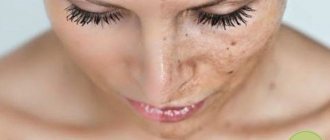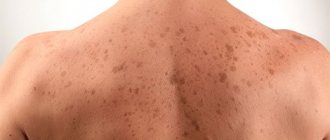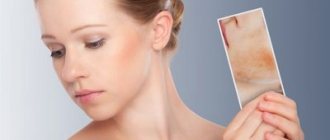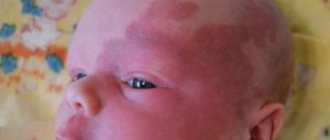Moles after sunbathing are a problem familiar to many. They arise as a specific response of the body to direct exposure to UV radiation.
But, despite the fact that such neoplasms are considered safe, they are prone to malignancy. Therefore, if you have moles after sunbathing, you should understand whether they pose a health threat.
What is a mole?
From a medical point of view, a mole is a local skin defect characterized by the proliferation of capillaries or pigment cells, depending on the type. Most of these defects are harmless and can only cause cosmetic discomfort, but their existence on the body should not be taken lightly.
Video: why do people need moles?
Factors that provoke the appearance of moles:
- ultraviolet radiation;
- hormonal imbalance;
- heredity;
- menopause;
- pregnancy.
The sun in summer contributes to the appearance of new moles
In addition to hormonal disorders and heredity, ultraviolet radiation influences the increase in the number of moles on the body. Over the years, the number of moles increases and they need to be carefully protected from the sun. Sun exposure can cause skin cancer. With melanoma, a nodule or dark spot appears on a certain area of the skin.
Ultraviolet radiation penetrates through clothing, its aggressive influence causes the appearance of age spots, freckles, and skin aging. If you approach sun exposure in the summer wisely, you can strengthen your nervous system, nourish your body with beneficial vitamin D and simply improve your mood.
Reasons for the appearance of moles on the body after sunbathing
Tanning is a natural reaction of the skin to stimulation by ultraviolet radiation. So why do moles appear after a solarium or from tanning in the sun?
Ultraviolet light stimulates the production of melanin, a polymer responsible for the color of living tissues of the body. During the irradiation process, the skin loses moisture and becomes denser, which together provokes the appearance of new moles.
What threat does the appearance of moles after sunbathing pose?
A common mole (pigmented nevus) is a round-shaped change in the color of the skin. The color is uniform and hair growth may be observed. Flat moles of dark brown and bright pink colors are considered safe. But it is worth remembering the risk of melanoma by taking good care of your skin and monitoring its condition.
The appearance of moles after solarium
Changing skin pigmentation is exactly the process that is achieved by visiting a solarium. Therefore, a skin reaction in the form of freckles or several new small moles is not dangerous. The changes will go away after 2-4 weeks without sun. But, if dark red, burgundy, or bluish moles appear after tanning, the risk of melanoma formation increases to 14–23%.
Under the influence of ultraviolet radiation, the structure of the cell changes, photochemical processes are launched that stimulate the proliferation of melanocytes. The skin, under the influence of the coloring pigment, changes color.
Stages of education
- The UV ray penetrates the skin.
- The immune system triggers a response - the production of melanocytes.
- The longer the exposure to rays, the more pigment is produced.
- Photosynthesis of cells forms a protective barrier - tanning.
- With a tendency to pigmentation and excessive tanning, moles are formed.
The skin changes color due to the production of a protective substance against the sun, darkening appears. The more sunlight, the more powerful the barrier.
But the appearance of moles indicates a disruption in the photosynthesis of cells under the influence of UV radiation. Typically for people with fair skin prone to burns. It is also not recommended to visit a solarium if there are a lot of freckles on the dermis, during pregnancy (when, under the influence of hormones, metabolism changes).
How to prevent the development of “bad” moles?
If you notice that moles have appeared after tanning or tanning in the sun, there is no need to panic! First of all, you need to regularly monitor the condition of your skin.
In any case, you need to make an appointment with a doctor immediately. He will conduct an inspection and give his recommendations.
After each sunbathing, it is necessary to independently examine the surface of the skin for the appearance of new changes in pigmentation or changes in the size and structure of old tumors. As soon as you notice something suspicious, immediately make an appointment with a dermatologist.
Video: which moles are dangerous to health
Reasons for concern and urgent appointment with a dermatologist or even an oncologist:
- rapid growth of a mole;
- the size of the new mole is one centimeter or more;
- color change;
- change in structure;
- the appearance of an ulcer,
- redness of the skin next to the tumor;
- itching, dryness or even pain.
If moles with these characteristics appear from sunburn, you should not hesitate. You need to contact a specialist immediately!
A specialist, having examined the moles, will determine what to do, whether it is worth removing them and which ones.
Removal methods
If the doctor decides to remove moles that appeared after a solarium or tanning in the sun, then this can be done in the following ways:
- Surgical removal . The oldest method that leaves noticeable marks on the skin after the procedure. It is used only in extreme cases when the use of more modern technologies is impossible for good reasons. An imperfect method that severely injures the skin.
- Radio knife . Non-contact method with minimal risk of infection. The wound heals quickly and does not require increased monitoring. Used for shallow tumors.
- Laser removal is a modern and fast way to get rid of tumors and skin defects. Advantages of using laser technology: speed, accuracy, lack of inflammation, deep removal. The laser-treated area finally heals and is compared with the general surface within two months. Before the procedure, a doctor's consultation is required to make sure that the skin growth is not malignant.
These are the ways to get rid of a mole that appears after sunbathing. The attending physician will determine which method is suitable for a particular patient.
It has been proven that excessive exposure to the sun provokes the growth of tumors on the skin, as well as the degeneration of existing ones into malignant ones. Therefore, you need to be careful.
Some countries have particularly high rates of malignant neoplasms. For example, in sunny countries - the USA (in some states) and Australia. Residents of northern countries, who spend much less time in the sun, should not relax either. In Russia, active prevention of melanoma is also underway.
It is important to follow simple rules for sunbathing: appear in the sun only during safe morning and evening hours, stay in the sun for no more than two hours, avoid redness and sunburn, take a shower before tanning sessions after swimming in salt water, use cosmetics to protect against uv rays.
It is necessary to regularly examine your skin or ask loved ones for help with this procedure. If suspicious tumors appear, immediately go to the doctor. If necessary, immediately remove moles that cause discomfort or pose a serious threat to health. It should be remembered that prevention and compliance with recommendations will help avoid resorting to painful surgical procedures.
Tanning rules
Based on the above, the obvious question arises: if everything is so scary, is it worth sunbathing at all? Sunbathing is necessary, but everything should have moderation. To avoid complications in the future, you must adhere to the following rules:
- if there are already a lot of moles on the body, then the time spent in the sun should be reduced to a minimum;
- if there is a small amount of nevus on the body, you should also not overdo it with tanning: remember that UV rays have a negative effect on existing moles, transforming them into malignant formations, and over time this will cause more and more of them to appear, take sunbathing under an umbrella, covering moles with clothes;
- avoid sunbathing at noon, as it is most harmful to the epidermis; when visiting the open air, wear long sleeves and a hat;
- people who are naturally fair-skinned, as well as those who have problems with the heart or blood pressure, do not need to be exposed to open rays for a long time;
- salt water greatly increases the impact of UV rays on human skin, so after swimming in sea water, rinse with fresh water and dry your body with a towel;
- Before a tanning session, you should not neglect the protective cream, because it helps the skin fight the sun's rays, making their impact less harmful to the epidermis and existing moles;
- When choosing a sunscreen, you should consider the following things: your skin type, the level of tanning you have, and the amount of time you spend outdoors.
It should be noted that no product, no matter how good it is, will provide 100% protection from harmful rays. It is also a mistaken belief that moles can be protected from the sun with a plaster. Indeed, UV rays are not able to penetrate through it, but the patch also closes the passage to the problem area and fresh air. As a result of the lack of ventilation under the patch, the temperature rises, and the skin begins to intensively produce sweat glands, which will lead to a greenhouse effect and the development of microbes. In addition, an already inflamed nevus can be injured under such cover.
Dark skin is not only beautiful, but also dangerous to health, or rather, the method by which you can get a tan is dangerous. If moles or age spots appear after sunbathing, they should be closely monitored. In case of visible changes, you should immediately contact a specialist. Remember that it is better to prevent unwanted consequences in advance than to observe a disastrous result later. Thus, despite the fact that tanning and moles are quite compatible, you need to combine them carefully.
Why do moles appear after sunbathing?
The appearance of moles is influenced by many factors: genetic predisposition, hormonal imbalances, aging of the skin. The most significant is the impact of ultraviolet radiation.
Moles or pigmented nevi are accumulations of melanocytes. Cells of the body that contain the pigment melanin. It creates a barrier against the pathogenic effects of ultraviolet irradiation on the skin and the penetration of rays into the deeper layers of the skin. For this reason, in the summer, human skin takes on a darker shade.
During the warm season, freckles appear more intensely.
If the radiation was not distributed evenly, melanin production may be focused in specific areas. This often happens on beaches when a person, after leaving the water, does not dry off. Drops of water on the skin act as lenses, increasing the degree of solar influence. Moles appear after a sunburn. This can happen if there is a disease in the body that disrupts the concentration of melanin.
Moles appeared after sunbathing – All about Health
Often moles form on the skin as a result of prolonged exposure to ultraviolet rays (under the sun, in a solarium). They are a signal that the procedure needs to be completed. If you do not take this into account, ultraviolet radiation will damage the skin and birthmark. A burn can cause adverse consequences in the form of cancer.
Bezokov explains: what is a mole?
In medical practice, a birthmark is considered a skin defect. Nevus provokes the proliferation of capillaries and pigment cells (depending on the variety). Most neoplasms do not pose a threat.
They only cause cosmetic discomfort. Experts are divided on what moles are for. Some people believe that they protect against aggressive environmental influences.
Others suggest that benign tumors increase the risk of cancer.
Moles may be dark or red. Some types have a convex shape, protruding above the skin. Others are located at the same level as the epidermis. The appearance of dark spots is caused by the accumulation of melanocytes.
The darkness of human skin depends on their concentration in the body. With prolonged exposure to the sun, there are more melanocytes in the solarium. These elements protect the skin from excessive radiation, forming a tan. Sometimes melanocytes join together.
Thus, a birthmark appears.
Its formation can be triggered by the following factors:
- ultraviolet irradiation,
- hormonal imbalances,
- hereditary predisposition,
- menopause,
- pregnancy,
- x-ray and radiation exposure,
- infection with viruses and injury to the epidermis.
Moles larger than 5 mm can develop into malignant neoplasms. Therefore, they must be protected from radiation and damage.
Why do moles appear after tanning in the sun and in a solarium?
As mentioned earlier, nevi occur as a result of a large accumulation of melanocytes. These substances protect the skin from the negative effects of ultraviolet radiation. Under the sun and in the solarium, their concentration increases.
The skin becomes darker and a tan appears. This is a barrier to the penetration of ultraviolet rays into the deeper layers of the epidermis.
A change in color warns a person about excessive exposure to the sun, in a solarium.
When exposed to ultraviolet rays, dark birthmarks appear. But sometimes they may not be noticeable by visual inspection. This is due to the lack of coloring pigment in nevi.
How dangerous are moles caused by tanning?
The most dangerous tan is acquired between 11:00 and 16:00. At this time, even the shadow is not protection. Many people don't know that if moles appear, you need to stop sunbathing. Continued exposure to ultraviolet rays is extremely dangerous. People with fair skin usually get sunburned. They are more likely to develop birthmarks.
Such changes in birthmarks indicate a high risk of degeneration into malignant neoplasms. If you notice the listed phenomena, you should immediately contact an oncologist.
Cancer cells spread quickly throughout the body and can affect various lymph nodes.
Moreover, not only new moles, but also those that have been observed on the body for years are capable of degenerating into oncology.
The dangers of sun exposure to skin
People are looking forward to the arrival of summer; it is associated with active recreation, trips to the sea and sunbathing. But the sun is fraught with danger to the human body.
Under the influence of sunlight, pathological conditions can develop that are difficult to get rid of:
- Photoaging. Despite the attractive appearance of tanned skin, the skin quickly ages under the influence of ultraviolet radiation. The tissues become denser, dry out, and become rough. Such skin quickly loses elasticity and sags.
- Photosensitization. Some people pay attention to the occurrence of rashes and allergic reactions after being in the sun. The phenomenon is due to the fact that some components of the cosmetics used react with ultraviolet radiation. As a result, irritation and inflammation appear.
- Hyperkeratosis is caused by exposure to ultraviolet radiation. The skin becomes rough and rough. Cracking is observed in some places. The skin looks chapped and exhausted.
- Sunburn. A common consequence of excessive sun exposure. People with fair skin are susceptible. The skin becomes red, painful, and begins to itch. Over time, the tissues are renewed, sometimes additional moles from the sun appear at the site of burns.
- Melanoma. One of the most dangerous types of skin cancer. The disease occurs due to the cellular degeneration of nevi. Ultraviolet exposure is a provoking factor for this disease. The more a person is exposed to aggressive rays, the higher the risk of transformation of formations.
It should be understood that the more formations there are on the body, the higher the likelihood that one of them will trigger the process of degeneration. New growths on the head are much more dangerous than those on the limbs. It's all about the barriers created by the lymph nodes.
According to research, melanoma most often affects people living in regions with particularly solar activity (Australia, southern USA, Thailand). A connection is established between the harmful effects of ultraviolet radiation on the human body. Tanning itself is not dangerous to humans. But its excess leads to health problems.
Oncologist answers questions about sun damage, melanoma and sunscreens
Melanoma is a malignant tumor that most often develops from melanocytes, the cells that produce the dark pigment of the skin, when exposed to sunlight.
UV radiation from the solar spectrum is divided into three ranges depending on wavelength. The shortest UF-C rays barely reach the Earth's surface thanks to the ozone layer. UF-B and UF-A are rays that penetrate the atmosphere and affect the skin.
UF-B, as shorter wavelength radiation, has more energy and burns the skin more strongly, causing superficial burns.
UF-A does not burn as much, but it penetrates deeper into the cellular layers of the skin, leading to noticeable and dangerous consequences - photoaging, skin cancer and melanoma (besides melanoma, skin cancer also includes two types of carcinomas, and melanoma itself is often classified as a separate type of malignant skin tumors - Ed.).
Since melanoma most often develops on the skin, unlike other cancers, it is quite easy to detect on your own.
We all take risks to some extent because we live under the sun. But not everyone takes the same risks.
Depending on the color of the skin, doctors distinguish six skin phototypes in people.
Representatives of the first and second phototypes - fair-haired and red-haired, with fair skin and freckles, those whose skin under the influence of the sun does not form a long-awaited tan, but quickly reacts with sunburn - should be wary of the sun.
The same applies to people with a large number of moles (50 or more pieces) or owners of congenital large nevi (the medical term for moles and birthmarks. - Ed.) with uneven edges, asymmetry and uneven coloring.
90% of the sick are people of these categories. The remaining 10% are people with hereditary melanoma. Those who have close blood relatives have ever had melanoma.
First of all, conduct regular self-examinations. The standard for identifying a “doubtful” mole is the ACCORD technique. This is an acronym for the factors you need to look for to detect superficial spreading melanoma, which looks like a flat spot—the most common form of the disease.
- Asymmetry. If the conditional axis divides the mole into two unequal halves (especially if the mole was previously symmetrical).
- Edge. If it becomes uneven, torn, with nicks.
- Bleeding. If a mole without previous injury suddenly begins to bleed.
- Color. The appearance of color changes, inclusions of darker or lighter, or disappearance of color may indicate degeneration.
- Size. An increase in the width or height of a mole can be a dangerous symptom.
- Dynamics. The appearance of crusts, cracks, and hair loss will also remind you of danger.
But melanoma can also be a dark, lumpy nodule that appears spontaneously and grows rapidly.
This is why it is so important to examine your body and monitor the appearance of new birthmarks or their growth, even in non-obvious and hard-to-reach places: on the back, back of the thighs, feet.
It is important to remember that self-examinations are not a substitute for visiting a doctor - especially for those who are at risk.
Any sunburn received outdoors or in a tanning bed can lead to the formation of melanoma over time. Therefore, the main prevention is related to protecting the skin from sun rays.
If possible, you should completely avoid tanning: wear long clothes, hats, sunglasses, and be sure to use sunscreen when going out into the open air, including in winter.
Do sunscreens work?
Today there is no direct evidence that the cream will 100% protect us from melanoma. But the right additional protection can reduce the risk.
When choosing a sunscreen, pay attention to the UVB and UVA labeling. The UVB symbol means that the product protects you only from UF-B rays, that is, only from sunburn.
But the packaging of good creams will also contain the UVA marking - in this case, the product will also protect you from the rays that cause melanoma.
It's important to apply a generous layer of sunscreen to all exposed parts of the body, including the eyelids—studies show these are the areas of skin most often missed when applying sunscreen creams.
Diagnosis of moles after sunbathing and methods for their removal
Diagnostics is the main step before removing benign growths. It is necessary to fully assess the condition of the nevus and identify the degree of its possible degeneration.
A diagnostic examination is carried out by visual inspection of the problem area. A dermatologist determines the symptoms of malignancy based on the following criteria:
- asymmetry – the mole does not have a clear shape, looks like an abstract drawing;
- uneven edges – clear boundaries are blurred, additional spots are present;
- color – inclusions of other shades are observed;
- size more than 6 mm.
How to prevent emergence and degeneration
A person needs to understand that the fewer birthmarks on his body, the lower the risk of degeneration. We are talking about a quantitative ratio. Even one nevus can begin transformation if it is constantly subject to damage, including sunburn.
To protect yourself from the occurrence of moles and other pathological processes, you need to follow simple rules.
- In summer, you need to protect your skin with clothing.
- You should not be in the sun between 10.00 and 16.00.
- It is recommended to use sunscreen ointments or creams.
- The treatment should be carried out not only on the face and shoulders, but also on the back.
- After swimming in ponds, you need to dry yourself with a towel and then sunbathe.
- Doctors do not recommend overusing solariums.
A person cannot completely protect himself from the risk of degeneration of a mole. Several factors influence this likelihood to increase. It is forbidden to rip off or damage the nevus. The more times he is injured, the greater the threat. It is not recommended to remove tumors yourself at home; in parallel with a relapse, the likelihood of cell mutation increases. When visiting the beaches, it is recommended to cover large moles with a band-aid or a special sticker.
Moles in the sun
In the summer, Russian women are happy to expose their bodies to the sun. Carefully! Excessive tanning can turn into an extremely dangerous disease, warns Alexander Alexandrovich KOLOBYAKOV, an oncodermatologist from the Moscow Institute of Plastic Surgery and Cosmetology of the Ministry of Health of the Russian Federation.
– Doctor, we are going to talk about the harmful sun, and you yourself are tanned as if you had been lying in the sun for hours.
– Indeed, I myself adore the sun and love sunbathing. Reasonable communication with the sun is beneficial: under the influence of rays, the body produces vitamin D, which is responsible for strong bones and teeth, the circulatory system and nervous system are strengthened, and immunity is increased. But you need to sunbathe wisely, so let's start with rule number one: you should sunbathe only during those hours when the sun's rays are not too active - in the morning before 10 o'clock, in the evening after 17 o'clock. It is better to spend the time from 12 to 17 hours in the shade - during these hours the scorching infrared radiation is especially strong. – And for those whose skin is already dark, exposure to the sun is not so scary? – It all depends on the amount of melanin, which protects the skin from solar radiation. Indeed, everyone has a different skin type, and the amount of time spent in the sun matters. For example, just half an hour in the sun can cause completely different skin reactions in different people. A dark-skinned person has a lot of melanin, so the protective reaction is stronger and no traces of exposure to the sun will remain. In a white-skinned, especially red-haired, blue-eyed person, in a pronounced albino with delicate skin, during the same time a burn occurs that is extremely harmful to the skin.
– So, it’s harmful for red- and white-skinned people to sunbathe?
– For people with fair skin who have little melanin pigment in their skin, prolonged exposure to the sun is really dangerous. Especially for those who have a lot of moles. For example, among white-skinned residents of Australia, where the sun shines all year round, the incidence of melanoma, a cancer, increases sharply. The same thing happens with our compatriots in Israel - after all, not everyone lived in tropical heat before, most spent their entire lives in the middle zone with moderate solar radiation. Both types of rays are considered dangerous: infrared rays cause redness and burns, which can provoke the degeneration of moles. Ultraviolet radiation is a known provocateur of melanoma.
– Does it matter how long you stay in the sun?
– The total time of insolation, that is, exposure to the sun, is a decisive factor. It makes no sense to cover dangerous places with moles with a towel or a Panama hat, or cover moles with a band-aid - melanoma does not sleep even under such cover. A burn increases the risk of disease many times over. – Solariums are very fashionable now – radiation exposure there is strictly dosed. Is this kind of tan harmful?
– Solarium is absolutely contraindicated for those who have many moles on their body. Moreover, women do not know the limits - just mulatto women come to me and ask to look at enlarged moles - well, what can I say? The fashionable craze for tanning is becoming life-threatening.
– Who is most often affected by melanoma?
– It is extremely rare in children. Melanoma affects people in middle and old age. Moreover, in older people on the face it is somewhat easier and the prognosis is better. In young people, melanoma affects the limbs and torso, with the worst prognosis for red-haired people.
– Is this disease hereditary?
– I would say that a predisposition to the disease can be hereditary, and those who have had cases of melanoma in their family should be especially careful. But the disease itself provokes a number of circumstances and life situations.
– How does this dangerous disease begin?
– It is extremely rare that it can begin on clean, healthy skin, and the sun is the first provocateur of the disease. But usually this happens at the site of nevi, or ordinary moles. Increased cell division occurs, and the mole may begin to transform. Most often, doctors call such moles melanomatous. - How do they look?
– Usually these are acquired moles, not congenital ones - the latter degenerate much less frequently. These are not necessarily raised or hairy moles; most often, flat ones can be dangerous. Moles located in places not covered with hair are also more likely to degenerate - on the soles, on the palms, on the inside of the shoulders and thighs. By the way, you should not be afraid to remove such moles for preventive purposes - they are likely candidates for degeneration into life-threatening ones.
– It turns out that almost all moles are dangerous?
– Every person is born with a certain number of moles. There are no people without moles. If during life, especially before puberty, they grow in proportion to body height, this is normal. If they begin to grow faster, as if outstripping human growth, this should be alarming. Such moles should be regularly shown to an oncodermatologist.
– What can trigger the growth and degeneration of a mole?
– Mainly injuries. If you accidentally hit a mole or get injured, rush to the doctor. But not to a beauty salon or to the first medical institution you come across, but to a specialized one, where there is an experienced oncodermatologist. Unfortunately, there are too many cases where a mole is removed without consulting an oncologist or hair is removed from a mole using an electroepilator or tweezers. This should not be done under any circumstances, since inflammation often occurs after such an intervention, and this can become a trigger for the growth of a mole and the degeneration of normal cells. In addition to trauma, there are also ordinary life situations. For example, during pregnancy, moles can change appearance and color, since during this period all processes in the body occur most rapidly. Sometimes a mosquito bite can cause a mole to degenerate: you scratched the mole once, twice, combed it, a crust appeared, you tore it off, it grew again - in general, another injury. Moles can also become injured when washed with a very hard washcloth. You should make it a rule: if there are a lot of moles on your body, wash only with a soft sponge, and generally gently wash protruding moles with your hand. By the way, those moles that are constantly under the strap, on the belt, on the neck, where you wear a chain, at the point of contact with the edges of the underwear and are subject to pressure or friction, it is better to remove them in advance, prophylactically. But only after consultation with an oncologist. And I repeat once again: sun exposure remains one of the main causes of melanoma. It is not possible to trace to the end how the trigger mechanism for degeneration develops; most often it happens unnoticed. Therefore, you need to be attentive to moles and monitor them. Unfortunately, sometimes doctors in cosmetic hospitals do not always know how to approach the problem competently. - How? It seems that you clearly said that it is impossible to remove a mole without consulting an oncodermatologist?
– Yes, but in what way – that’s the question. For example, if a doctor determines a mole to be melanoma-dangerous, it only needs to be excised surgically; all others can be removed with electric current. If the diagnosis is made incorrectly, the consequences can lead to tragedy - I am not exaggerating. So a consultation, perhaps with several oncodermatologists, is necessary. – How not to make a mistake in choosing a specialist? – You should only contact large specialized centers with solid experience. If necessary, the doctor examines the mole with a special device - a dermatoscope. This is a lighted magnifying glass.
– Is it possible to somehow prevent the disease?
– Unfortunately, melanoma remains one of the most insidious oncological diseases and rarely makes itself known in advance. We must try not to injure moles; if this happens, run to the doctor, remove moles prophylactically at friction points, observe melanoma-dangerous moles preferably from the same experienced doctor, in order to have a clear dynamics of development. – What should alert the patient and the doctor?
* Disproportional growth of the mole. * Changing the color of a mole - both darkening and whitening are dangerous. * Bleeding, ulceration. * Hair loss from a mole. * The appearance of itching at the site of the mole. * Redness - inflammatory areola around the mole. * The appearance of new moles. * Changes in the mole - compactions, spots. * Violation or complete erasure of the skin pattern on the mole. * Peeling. – What advice do you want to give to our readers?
– The main thing that I want to emphasize once again is that if you find even the slightest alarming sign, run to the doctor as soon as possible.
*** For those who have not yet been on vacation, we offer several rules for proper behavior in the sun. By following these simple recommendations, you will not only improve your health, but also reduce the risk of a dangerous disease. * Staying in the sun is safe from morning to 10 o'clock, in the evening after 17 o'clock. * For people with a large number of moles, it is better to reduce their exposure to the sun. Solarium is prohibited for you. * Never allow your skin to become red or sunburned. If this happens, spend 2-3 days in the shade. * After swimming in the sea, be sure to rinse your skin with fresh water. Salty drops create a lens effect - the sun burns through the skin. * Even young and healthy people can spend no more than one and a half to two hours a day in the sun. * Infants should not be in the sun. * Taking certain medications increases the skin's sensitivity to light. Please consult your GP before going on holiday. * Clothing does not completely protect the skin from the sun: cotton transmits 6% of sunlight, and up to 20% when wet. * Even when underwater at a depth of half a meter, the skin absorbs 60% of the radiation. Bathing should be included during sun exposure. * Increase the radiation dose by no more than 20% from day to day. * Use sunscreen cosmetics: at the beginning of the holiday, the indicator should be maximum, about 40 units. * Do not use decorative cosmetics, deodorants and perfumes on the beach - they can cause the appearance of age spots on the skin. NULL
What symptoms should you see a doctor for?
In order to detect the development of a dangerous disease in time, it is necessary to consult a doctor in a timely manner. Suspicion should be raised by the following symptoms:
- pain when touched;
- inflammatory processes;
- education began to grow rapidly;
- the skin around the area has become red;
- swelling;
- itching;
- small moles appeared around;
- the nevus has divided into several parts;
- periodic bleeding;
- The color of the birthmark changed from brown to black.
A timely visit to a doctor will allow you to identify the disease at an early stage and carry out relevant treatment. The listed signs cannot be ignored. It must be remembered that melanoma is a particularly aggressive cancer with active metastasis, it is difficult to treat in advanced stages, and gives a disappointing prognosis.
Moles that appear after sunbathing are not only a cosmetic defect. They can provoke the development of a dangerous condition. A person needs to provide maximum skin protection during periods of solar activity. If additional moles appear after sunbathing, you should visit a doctor.
How dangerous are the sun's rays?
People often ignore the appearance of new birthmarks. Continuing to systematically stay under ultraviolet radiation, they cause serious harm to their body. The sun damages not only the surface of the skin, but also nevi, which can result in various malignant tumors.
The sun has a particularly dangerous effect from 10.00 to 16.00. Even if you are in the shade at this time, a person will not be able to avoid negative ultraviolet radiation. It is also not recommended to expose your skin to such radiation for people with fairly fair skin, which has a low protection threshold due to a small amount of melanin. Often after sunbathing, they may develop birthmarks of quite large sizes.
In addition, there is a group of people for whom birthmarks caused by tanning pose a particular threat.
The presence of factors such as a genetic predisposition to skin cancer, the formation of clusters of moles with a diameter of 6 mm and the presence of freckles should raise suspicion. In such cases, immediate examination of neoplasms is required.
If moles appear after sunbathing and there is an intensive growth of them, a change in outline and shape, and the release of bloody fluid, you should not hesitate, but immediately contact a specialist, in this case an oncologist. Such symptoms may indicate the degeneration of a nevus into a malignant tumor. Under the influence of the sun, long-existing moles can also transform from benign to malignant.
Melanoma, or skin cancer, is a dangerous but treatable disease. If you consult a doctor at the first suspicious symptoms, you can avoid the appearance of metastases. Having made a diagnosis, the oncologist will prescribe the necessary treatment. If the disease is already at an advanced stage, it can be fatal.
Degeneration of nevi may not occur immediately after prolonged exposure to sunlight. Sometimes this process in the body starts only after a few years. To identify melanoma at an early stage, it is necessary to pay attention to the following signs after intense tanning:
- the mole is divided into two asymmetrical parts;
- nevus of significant size (more than 1 cm in diameter), since large formations more often become malignant tumors than small ones;
- the mole has uneven, blurry edges;
- the color of the nevus is heterogeneous: pink, gray and even black colors are mixed;
- cracks appear on the surface of the birthmark;
- pain or itching occurs.
It happens that moles appear after sunbathing and any of the indicated symptoms are observed, then the doctor diagnoses melanoma. In this case, removal of the malignant tumor is required.










